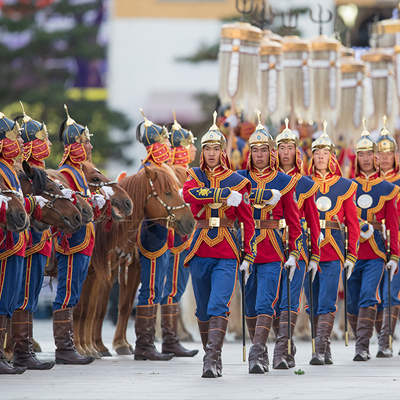
Mongolia In Early Period
Xiongnu or Hun state
The Xiongnu was existed on the confederation of 24 tribes and led by Tumen khan in 209 BC. The bulk of information on the Xiongnu comes from Chinese sources. What little is known of their titles and names comes from Chinese transliterations from their language. Eastern steppes were dominated by the nomadic people Xiongnu from the 3rd century BC. Archaeological discoveries indicate that Hun territory covered a vast area from Lake Baikal to Chita in the north, the whole of present-day Mongolia, and as far south as the Yellow River and Ordos in China organized defenses against the marauding nomads, developing their cavalry and building fortifications. These were linked together to form first stage of the Great Wall of China by the first emperor of the Qin dynasty (221-207).
Our knowledge of this early period comes from Chinese annals whose authors naturally gave Chinese names to the various ruling dynasties, although they were not all Chinese. Their descriptions of the physical appearance and dress of the Xiongnu, and their titles and military organization, suggest that they were similar to the later Turks and Mongols. Under their ruler, the shanyu, the Hun’s devastate what is now North China, besieging the Han dynasty capital of Taiyuan and driving the Yuehchih (Tocharians) westwards out of Gansu, a region in North China. Divisions amongst the Huns (AD25-220) and their eventual defeat by Han China put an end to this threat. China was then able to gain control of Turfan and the Silk Road through what is today called Xinjiang. The northern Huns in the Orkhon valley were subjugated around AD155 by Mongol Xienbei tribes.
The southern Huns established a dynasty called the Northern Han, proclaimed in AD308 by Han chief, Liu Yuan, at Taiyuan; they captured the Chinese Han dynasty capital Loyang. This was a period of great instability, with much of northern China overrun by nomadic tribes. Their leaders’ feuding led to the Huns’ decline, division and eventual dispersal. The western Huns reached the Carpathians and Hungary in the 5th century AD. In AD441, Attila crossed the Danube but, in AD451, his advance cross France was halted by the Roman and Visigoth armies at Troyes. Attila’s empire disintegrated after his death in AD453.
Rouran
In the 4th century, northern China was dominated by the Northern Wei dynasty of the Toba Turks, who fought with the Mongolian Jujuan tribes for control. So Jujuan was the name of a confederation of nomadic tribes on the northern borders of Inner China from the late 4th century until the late 6th century. It has sometimes been hypothesized that the Rouran are identical to the Eurasian Avars who later appeared in Europe. The Jujuan forced the Xiongnu to the north-west, their ruler Shelun assumed the title ‘Khagan’ (khan) in 402. His capital was in Arkhangai province in central Mongolia. His state was eventually weakened by division, and the Jujuan khanate was absorbed by the Altai Turks.
The Turks
The Turks, known to the Mongols as Tujue, formed an alliance in 546AD under their chief, Tumen, with the now sinicised Toba to defeat th Jujuan. The Turkic khanate under Tumen established its capital in the Orkhon valley-often called the cradle of Mongolian civilization. Known as the Orkhon Turks, they were excellent craftsmen in iron and stone, besides being herdsmen, hunters and warriors. Monuments to their leaders are inscribed in Turkish runic script on stele, standing stone slabs that still survive today in the Mongolian countryside. In AD553 Tumen’s son became khan of the eastern khanate (Mongolia), while his brother received the western khanate. After 50 years of rule by Tang dynasty China, the Turks re-established their khanate, but violent revolt and infighting broke out among the tribes, which led to the destruction of the Turkish khanate in AD745 and the supremacy of their former Uighur subjects.
The Uighur
The Uighur khanate which followed reached its peak under Moyunchur khan (AD745-59). The Uighurs made their capital at Khar Balgas on the Orkhon River. Empire was a Turkic empire that existed in present day Mongolia and surrounding areas for about a century between the mid 8th and 9th centuries. It was a tribal confederation under the Orkhon Uyghur nobility. They were primarily shamanists but religions such as Buddhism, Manichaeism and Nestorian Christianity were permitted. They adopted the Sogdian script that the Mongols later utilized for their language. Attacked by the Kirghiz from the north, the Uighur khanate declined in AD840. The Kirghiz themselves were threatened and eventually driven away by the Kidan, a tribe related to the Mongols.
The Kidan
At its greatest strength, the Kidan state (911-1125) controlled central Mongolia and much of northeastern China and established a hereditary monarchy known as the Liao. The Kidans were an ethnic group whose language belonged to the Mongolic group. Kagan Ambagyan founded the Kidan state in 911. The Kidan state covered a significant portion of what are now Mongolia including the basins of the rivers Kerulen, Tuul and Orkhon. The Kidan had their own literature in a script based on Chinese characters and a printing technology developed in the Kidan Empire. It was a settled period when the arts and sciences flourished, but in 1125, under the combined attacks of Song dynasty China and the Jin state of the Jurchen, the Kidan state collapsed.










.jpg)















